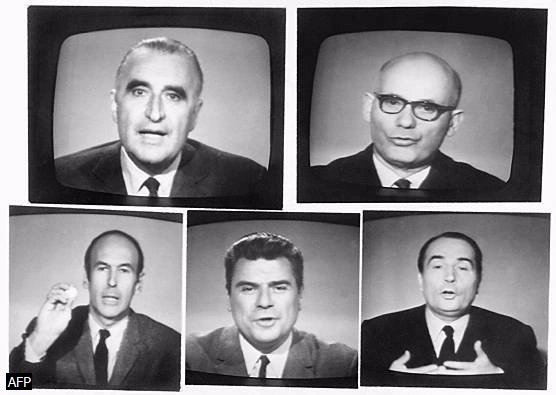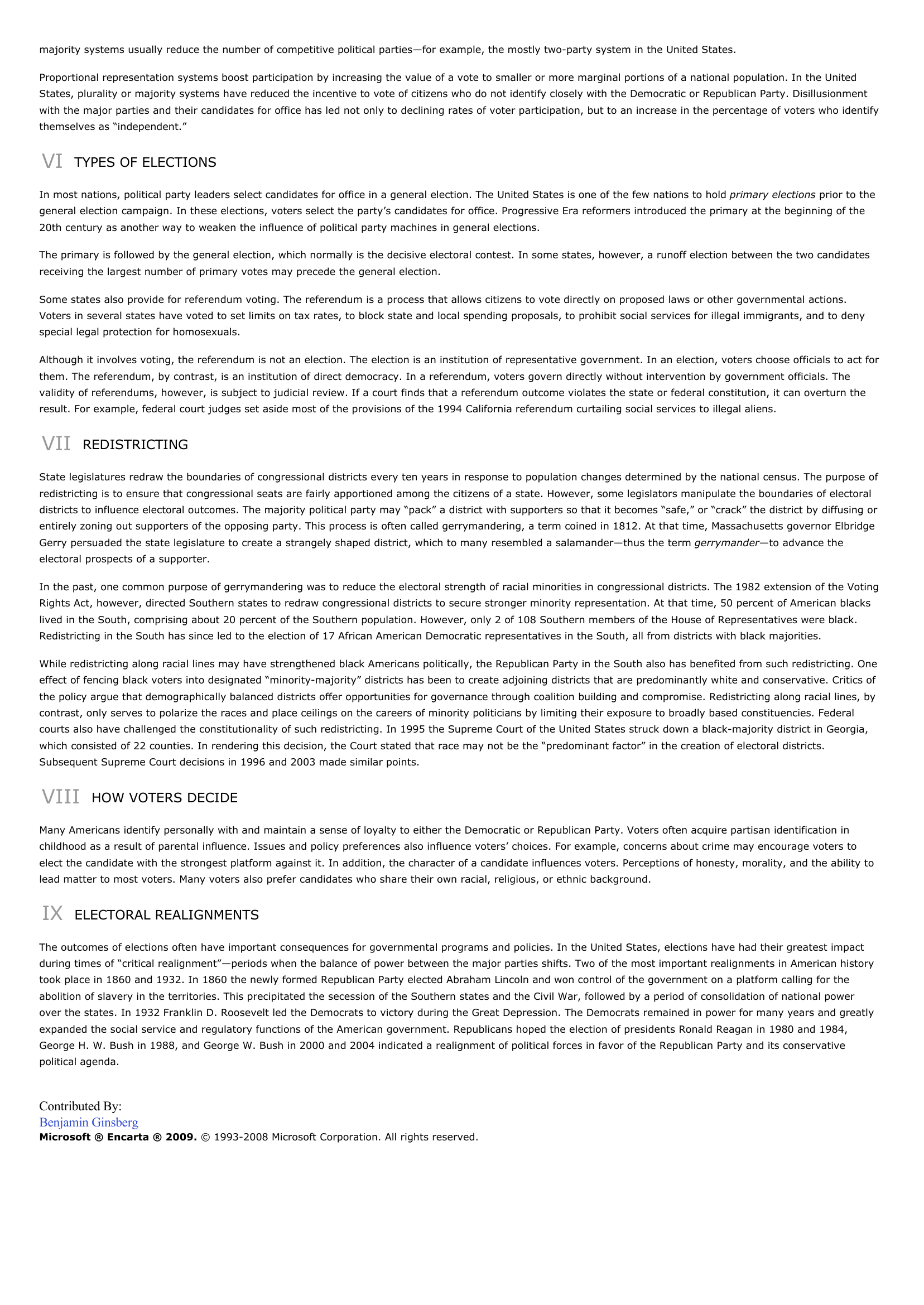Election.
Publié le 10/05/2013
Extrait du document


«
majority systems usually reduce the number of competitive political parties—for example, the mostly two-party system in the United States.
Proportional representation systems boost participation by increasing the value of a vote to smaller or more marginal portions of a national population.
In the UnitedStates, plurality or majority systems have reduced the incentive to vote of citizens who do not identify closely with the Democratic or Republican Party.
Disillusionmentwith the major parties and their candidates for office has led not only to declining rates of voter participation, but to an increase in the percentage of voters who identifythemselves as “independent.”
VI TYPES OF ELECTIONS
In most nations, political party leaders select candidates for office in a general election.
The United States is one of the few nations to hold primary elections prior to the general election campaign.
In these elections, voters select the party’s candidates for office.
Progressive Era reformers introduced the primary at the beginning of the20th century as another way to weaken the influence of political party machines in general elections.
The primary is followed by the general election, which normally is the decisive electoral contest.
In some states, however, a runoff election between the two candidatesreceiving the largest number of primary votes may precede the general election.
Some states also provide for referendum voting.
The referendum is a process that allows citizens to vote directly on proposed laws or other governmental actions.Voters in several states have voted to set limits on tax rates, to block state and local spending proposals, to prohibit social services for illegal immigrants, and to denyspecial legal protection for homosexuals.
Although it involves voting, the referendum is not an election.
The election is an institution of representative government.
In an election, voters choose officials to act forthem.
The referendum, by contrast, is an institution of direct democracy.
In a referendum, voters govern directly without intervention by government officials.
Thevalidity of referendums, however, is subject to judicial review.
If a court finds that a referendum outcome violates the state or federal constitution, it can overturn theresult.
For example, federal court judges set aside most of the provisions of the 1994 California referendum curtailing social services to illegal aliens.
VII REDISTRICTING
State legislatures redraw the boundaries of congressional districts every ten years in response to population changes determined by the national census.
The purpose ofredistricting is to ensure that congressional seats are fairly apportioned among the citizens of a state.
However, some legislators manipulate the boundaries of electoraldistricts to influence electoral outcomes.
The majority political party may “pack” a district with supporters so that it becomes “safe,” or “crack” the district by diffusing orentirely zoning out supporters of the opposing party.
This process is often called gerrymandering, a term coined in 1812.
At that time, Massachusetts governor ElbridgeGerry persuaded the state legislature to create a strangely shaped district, which to many resembled a salamander—thus the term gerrymander —to advance the electoral prospects of a supporter.
In the past, one common purpose of gerrymandering was to reduce the electoral strength of racial minorities in congressional districts.
The 1982 extension of the VotingRights Act, however, directed Southern states to redraw congressional districts to secure stronger minority representation.
At that time, 50 percent of American blackslived in the South, comprising about 20 percent of the Southern population.
However, only 2 of 108 Southern members of the House of Representatives were black.Redistricting in the South has since led to the election of 17 African American Democratic representatives in the South, all from districts with black majorities.
While redistricting along racial lines may have strengthened black Americans politically, the Republican Party in the South also has benefited from such redistricting.
Oneeffect of fencing black voters into designated “minority-majority” districts has been to create adjoining districts that are predominantly white and conservative.
Critics ofthe policy argue that demographically balanced districts offer opportunities for governance through coalition building and compromise.
Redistricting along racial lines, bycontrast, only serves to polarize the races and place ceilings on the careers of minority politicians by limiting their exposure to broadly based constituencies.
Federalcourts also have challenged the constitutionality of such redistricting.
In 1995 the Supreme Court of the United States struck down a black-majority district in Georgia,which consisted of 22 counties.
In rendering this decision, the Court stated that race may not be the “predominant factor” in the creation of electoral districts.Subsequent Supreme Court decisions in 1996 and 2003 made similar points.
VIII HOW VOTERS DECIDE
Many Americans identify personally with and maintain a sense of loyalty to either the Democratic or Republican Party.
Voters often acquire partisan identification inchildhood as a result of parental influence.
Issues and policy preferences also influence voters’ choices.
For example, concerns about crime may encourage voters toelect the candidate with the strongest platform against it.
In addition, the character of a candidate influences voters.
Perceptions of honesty, morality, and the ability tolead matter to most voters.
Many voters also prefer candidates who share their own racial, religious, or ethnic background.
IX ELECTORAL REALIGNMENTS
The outcomes of elections often have important consequences for governmental programs and policies.
In the United States, elections have had their greatest impactduring times of “critical realignment”—periods when the balance of power between the major parties shifts.
Two of the most important realignments in American historytook place in 1860 and 1932.
In 1860 the newly formed Republican Party elected Abraham Lincoln and won control of the government on a platform calling for theabolition of slavery in the territories.
This precipitated the secession of the Southern states and the Civil War, followed by a period of consolidation of national powerover the states.
In 1932 Franklin D.
Roosevelt led the Democrats to victory during the Great Depression.
The Democrats remained in power for many years and greatlyexpanded the social service and regulatory functions of the American government.
Republicans hoped the election of presidents Ronald Reagan in 1980 and 1984,George H.
W.
Bush in 1988, and George W.
Bush in 2000 and 2004 indicated a realignment of political forces in favor of the Republican Party and its conservativepolitical agenda.
Contributed By:Benjamin GinsbergMicrosoft ® Encarta ® 2009. © 1993-2008 Microsoft Corporation.
All rights reserved..
»
↓↓↓ APERÇU DU DOCUMENT ↓↓↓
Liens utiles
- Disputed Presidential Election of 2000 - U.
- Election américaine en 1944
- Federal Election Campaign Act
- Aristide, Jean Bertrand : Election présidentielle en Haïti (Podcast)
- Jean-Paul II : Election du pape (Podcast)

































